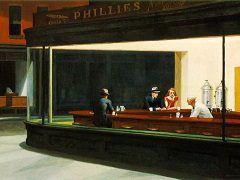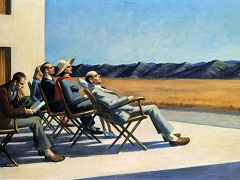Summer Interior, 1909 by Edward Hopper

Hopper's 1909 Summer Interior introduces the way in which he illustrates his repressed anxieties about independent women and their place in his world: his female nudes depict his fantasy in which the vulnerable female is confined within her domestic interior. The female figure's pose in Summer Interior is despondent: everything about her body moves the viewer's gaze lower. There is, therefore, a rather despairing tone that consumes the painting. The female figure is the painting's center: this "disconsolate" figure is the work's focus. The woman sits on a sheet that is falling from the unmade bed, adding to the work's quiet chaos. The woman is entirely engaged in her own thoughts, taking no notice of the viewer who stares at her.
A young woman, head down, face obscured, sits on the floor slumped against her bed. She wears only a white sleeveless shirt, leaving her genital region exposed. Her left arm stretches down between her legs, emphasizing her pubic area. Her right arm is bent at the elbow, and rests on top of the bed against which she leans. Other than the bed, the figure's room is barely furnished. A white fireplace stands at the foot of the bed, hidden almost entirely by the bed's footboard. A window is in the painting's right background, letting a patch of sunlight stream into the room. This patch is the painting's sole light source, yet the white of the bedsheets and the woman's top prevent the work from complete darkness. The painting's forms are not abstract, yet there is something hasty about Hopper's brushwork. The woman's right hand, for example, appears as a conglomeration of paint rather than a distinct corporeal form. The window is merely a rectangle with horizontal lines running across it, as though Hopper repeatedly dragged his paintbrush across the frame's outline.















